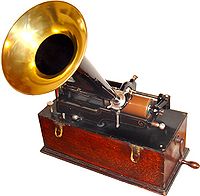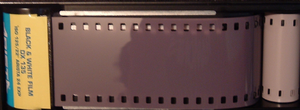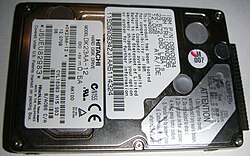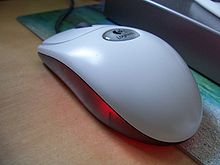Data storage device
From Wikipedia, the free encyclopedia
(Redirected from Storage Devices)
A data storage device is a device for recording (storing) information (data). Recording can be done using virtually any form of energy, spanning from manual muscle power in handwriting, to acoustic vibrations in phonographic recording, to electromagnetic energy modulating magnetic tape and optical discs.
A storage device may hold information, process information, or both. A device that only holds information is a recording medium. Devices that process information (data storage equipment) may either access a separate portable (removable) recording medium or a permanent component to store and retrieve information.
Electronic data storage is storage which requires electrical power to store and retrieve that data. Most storage devices that do not require vision and a brain to read data fall into this category. Electromagnetic data may be stored in either an analog or digital format on a variety of media. This type of data is considered to be electronically encoded data, whether or not it is electronically stored in a semiconductor device, for it is certain that a semiconductor device was used to record it on its medium. Most electronically processed data storage media (including some forms of computer data storage) are considered permanent (non-volatile) storage, that is, the data will remain stored when power is removed from the device. In contrast, most electronically stored information within most types of semiconductor (computer chips) microcircuits are volatile memory, for it vanishes if power is removed.
With the exception of barcodes and OCR data, electronic data storage is easier to revise and may be more cost effective than alternative methods due to smaller physical space requirements and the ease of replacing (rewriting) data on the same medium. However, the durability of methods such as printed data is still superior to that of most electronic storage media. The durability limitations may be overcome with the ease of duplicating (backing-up) electronic data.
Contents[hide] |
[edit] Terminology
Devices that are not used exclusively for recording (e.g. hands, mouths, musical instruments) and devices that are intermediate in the storing/retrieving process (e.g. eyes, ears, cameras, scanners, microphones, speakers, monitors, video projectors) are not usually considered storage devices. Devices that are exclusively for recording (e.g. printers), exclusively for reading (e.g. barcode readers), or devices that process only one form of information (e.g. phonographs) may or may not be considered storage devices. In computing these are known as input/output devices.All information is data. However, not all data is information.
Many data storage devices are also media players. Any device that can store and playback multimedia may also be considered a media player such as in the case with the HDD media player. Designated hard drives are used to play saved or streaming media on home entertainment systems.
[edit] Trends
International Data Corporation estimated that the total amount of digital data was 281 billion gigabytes in 2007, and had for the first time exceeded the amount of storage.[2][edit] Data storage equipment
Any input/output equipment may be considered data storage equipment if it writes to and reads from a data storage medium. Data storage equipment uses either:- portable methods (easily replaced),
- semi-portable methods requiring mechanical disassembly tools and/or opening a chassis, or
- inseparable methods meaning loss of memory if disconnected from the unit.
[edit] Portable methods
- Hand crafting
- Flat surface
- Fabrication
- Cylindrical accessing
- Memory card reader/drive
- Tape drive
- Mono reel or reel-to-reel
- Compact Cassette player/recorder
- Disk accessing
- Cartridge accessing/connecting (tape/disk/circuitry)
- Peripheral networking
- Flash memory devices
[edit] Semi-portable methods
[edit] Inseparable methods
[edit] Recording medium
A recording medium is a physical material that holds data expressed in any of the existing recording formats. With electronic media, the data and the recording medium is sometimes referred to as "software" despite the more common use of the word to describe computer software. With (traditional art) static media, art materials such as crayons may be considered both equipment and medium as the wax, charcoal or chalk material from the equipment becomes part of the surface of the medium.Some recording media may be temporary either by design or by nature. Volatile organic compounds may be used to preserve the environment or to purposely make data expire over time. Data such as smoke signals or skywriting are temporary by nature. Depending on the volatility, a gas (e.g. atmosphere, smoke) or a liquid surface such as a lake would be considered a temporary recording medium if at all.
[edit] Ancient and timeless examples

The Gutenberg Bible displayed by the United States Library of Congress, demonstrating printed pages as a storage medium.

A set of index cards in a file box are a nonlinear storage medium.
- Optical
- Any object visible to the eye, used to mark a location such as a, stone, flag or skull.
- Any crafting material used to form shapes such as clay, wood, metal, glass, wax or quipu.
- Any hard surface that could hold carvings.
- Any branding surface that would scar under intense heat (chiefly for livestock or humans).
- Any marking substance such as paint, ink or chalk.
- Any surface that would hold a marking substance such as, papyrus, paper, skin.
- Chemical
[edit] Modern examples by energy used
- Chemical
- Thermodynamic
- Photochemical
- Mechanical
- Pins and holes
- Paper
- Musical box cylinder or disk
- Grooves (See also Audio Data)
- Phonograph cylinder
- Gramophone record
- Dictabelt (groove on plastic belt)
- Capacitance Electronic Disc
- Pins and holes
- Magnetic storage
- Wire recording (stainless steel wire)
- Magnetic tape
- Drum memory (magnetic drum)
- Floppy disk
- Optical storage
- Electrical
- Semiconductor used in volatile RAM microchips
- Floating-gate transistor used in non-volatile memory cards
[edit] Modern examples by shape
A typical way to classify data storage media is to consider its shape and type of movement (or non-movement) relative to the read/write device(s) of the storage apparatus as listed:- Paper card storage
- Punched card (mechanical)
- Cams and tracers (pipe organ combination-action memory memorizing stop selections)
- Tape storage (long, thin, flexible, linearly moving bands)
- Paper tape (mechanical)
- Magnetic tape (a tape passing one or more read/write/erase heads)
- Disk storage (flat, round, rotating object)
- Gramophone record (used for distributing some 1980s home computer programs) (mechanical)
- Floppy disk, ZIP disk (removable) (magnetic)
- Holographic
- Optical disc such as CD, DVD, Blu-ray Disc
- Minidisc
- Hard disk drive (magnetic)
- Magnetic bubble memory
- Flash memory/memory card (solid state semiconductor memory)
- xD-Picture Card
- MultiMediaCard
- USB flash drive (also known as a "thumb drive" or "keydrive")
- SmartMedia
- CompactFlash I and II
- Secure Digital
- Sony Memory Stick (Std/Duo/PRO/MagicGate versions)
- Solid-state drive
[edit] Weight and volume
Especially for carrying around data, the weight and volume per MB are relevant. They are quite large for written and printed paper compared with modern electronic media. On the other hand, written and printer paper do not require (the weight and volume of) reading equipment, and handwritten edits only require simple writing equipment, such as a pen.With mobile data connections the data need not be carried around to have them available.
[edit] See also
- Archival science
- Blank media tax
- Computer data storage
- Content format
- Data transmission
- Digital Preservation
- Disk drive performance characteristics
- Format war
- Flip-flop (electronics)
- IOPS
- Library
- Media controls
- Medium format (film)
- Memristor
- Nanodot
- Nonlinear medium (random access)
- Recording formats
- Semiconductor memory
- Telecommunication









